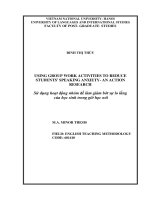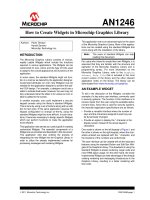A Group Introduction Activity to Create a Safe Atmosphere
Bạn đang xem bản rút gọn của tài liệu. Xem và tải ngay bản đầy đủ của tài liệu tại đây (66.27 KB, 4 trang )
A Group Introduction Activity to Create a
Safe Atmosphere
Clay Bussinger
In a large ESL class, which meets once or twice a week, students often feel reticent in
speaking. I found that having students help create a safe environment for themselves allows
them to use the language more readily. Group introductions seem to work very well in this
pursuit.
A Problem: Large Classes Inhibit Students From
Speaking Easily
Many students come to the classroom with their friends, or acquaintances they've made
from their major. There is a danger of a class becoming fractured into groups, cliques, from
the outset. To create a truly safe ESL-learning environment, I believe the class should come
together as a whole, become a single unit. While there may be no possible way to quantify
the effectiveness of using group introductions in creating a supportive, open atmosphere in
a language class, I have definitely noticed a marked improvement in the atmosphere in my
classes since I began using them.
The First Activity: Create Random Groups
The first task then is to break up the pre-formed groups, and create different groups for
introductions. There are endless ways to create new groups, and an easy way is for them to
number off, creating groups of four students. I put them into these groups immediately,
before telling them the reason why the group was made. I want them to look at each other
before they know they will have to introduce each other to the class.
Introducing a Dynamic Method of Introduction
After informing them that they are going to be doing group introductions, I usually see a lot
of puzzled looks, so the next step is to show them an effective method of introduction. Left
to themselves, usually they split into pairs, and Student A introduces his/her partner. This is
followed by Student B introducing his/her partner. Then Student C and Student D follow in
turn. This is a very static method of introduction and after two or three groups, the whole
exercise often dissolves into tedium.
A more interesting dynamic way of introduction is to have two students introducing the
other two at the same time, using the same topics, alternating after a few sentences. If for
instance the groups have 12 items to introduce of each other, Student A would introduce
Student B, using the first three items on the list.
Interview Questions and Discussion Areas
Depending on the time available, teachers may choose to give students prepared handout
for interviews, or have the students create their own questions to ask and areas to explore.
It is possible for each group of four to come up with their own questions, but this method is
rather haphazard, and often too time-consuming. A more effective method is to ask the
class as a whole to offer what they would want to know about their fellow students.To
begin the group formation you may have each group offer 10 categories each and write
them on the blackboard. The class can as a whole then choose which 10, 15 or 20
questions/categories they would most like to know about their peers. For myself, to save
time I give them a list of areas to inquire about, and specific questions to ask, most of
which I have I have collected from students suggestions in previous classes.
Typical Questions and Other Uses for Collected
Information
Besides the usual questions, from the obvious, Name, Family, Clubs, and the like, I like to
pose more open-ended questions -- future plans? Dreams? How would you like to see
yourself in 30 years? How would you like others to see you? What are three things we
should know about you?
I collect the completed interview sheets after the introductions are completed, therefore I
usually also ask the interviewers to ask questions that I would like to know for record
keeping and other purposes: email address, telephone number, major, travel abroad,
TOEFL score, TWE score and so forth. These questions change depending on the class,
and my needs for that particular class.
The Introductions Begin
After the order has been decided, and each group has a number, introductions begin. I
usually spend some time "on stage" with each group to try and make them feel relaxed and
safe. I ensure that the four students are lined up A, B, C, D. After Student A and Student D
introduce the center two students, the students exchange places and Student B and Student
C introduce the other two students. I have found that this arrangement is most relaxing and
conducive to a forthcoming presentation.
At the risk of being obvious, I will show a brief excerpt of a typical introduction:
Introduction Group: Naoto, Aya, Izumi and Nozomi
• Naoto: This is Aya She lives in Setagaya with her grandmother, father, mother,
younger brother, and her two cats, Mina and Tom.
• Nozomi: This is Izumi. She's from Yokohama, but now lives in the student dorm on
campus. She has a roommate from Canada, and is happy to have a chance to
practice English on a daily basis. There are four in her family: herself, her father,
mother and older sister, who's graduating this year from university. She has not
pets, but loves dogs.
• Naoto: Aya is majoring in International Relations, and her dream is to work for the
U.N. She's also interested in International Law. She belongs to the tennis club, and
in her spare time, she likes to cook.
• Nozomi: Izumi is a French major, but doesn't yet know what she wants to be in the
future. Izumi belongs to the ESS, English Speaking Society. She likes to watch
movies in her spare time.
Another pattern of introductions consists of Naoto and Nozomi both introducing Aya,
using several items. Then they will both introduce a few points about Izumi.
After Naoto and Nozomi complete their introductions, they change places with Aya and
Izumi, who in turn begin their introductions.
Follow-up Questions
After all interviews are completed, the class has a chance to ask follow-up questions. For a
higher level class, I would let the students ask questions as they wish. However, if the class
is reticent to speak, I will prompt them by calling on students to ask questions. When
necessary, I model follow-up questions. For lower level classes I assign the previous group
in the order to ask the questions. Students A ask their counterparts and so forth. It's better
that the previous group to ask the questions, thus allowing the following group to
concentrate on their upcoming presentation. For Basic Level classes, I write model
questions on the board to ask. Students can rely totally on these questions, though most
come up with their own questions. These follow-up questions ensure that the class is
involved in the introductions.
Each activity is designed to create a safe atmosphere, in which each student has a stake in
the successful completion of each oral assignment. It is important to me as a teacher that
the class become a unified whole, in which each student feels capable of speaking, capable
of saying something valuable, feels that others will support them, and feels a sense of
responsibility toward the other students in the class.
This Pattern is Repeated Throughout the Class
In a large oral communication class I have students regularly give group presentations
throughout the semester. I usually allow them to form groups according to their interests in
the various topics, topics that are offered by the students. This further breaks up cliques and
pre-formed groups. Students then follow a similar method of presentation and follow-up
question asking in these subsequent presentations. The students soon become familiar and
comfortable with this method. However the process is dynamic and does not seem to ever
lose its vitality and get stale.









